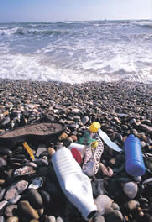|
It is not yet known whether the particles damage wildlife, say Richard Thompson of the University of Plymouth, UK, and his colleagues, who carried out the research. But their study has shown that the plastics are ingested by marine animals such as barnacles, which means that particles could end up in the human food chain.
Environmentalists already know that the world's seas are strewn with plastic debris such as bags and bottles. Although the chemicals from which they are made do not break down, Thompson's team has discovered that these items are ground down into tiny particles, much as rocks are transformed into sand.
The researchers combed 18 regions along Britain's coastline, collecting samples of seawater and sediment, and studied plankton collected by ships travelling between Scotland and Iceland over the past few decades. All specimens contained microscopic fragments of plastics including nylon, polyethylene and polyester, they report in the journal Science1.
"I expected to find this material, but I was surprised by how common it is," says Thompson. Many more particles may have gone undetected in the study, he adds, as the team can only spot brightly coloured particles that are larger than 20 micrometres in diameter.
Polluting cleaners
Many cleaning agents, as well as some supposedly biodegradable plastics, leave a residue of nondegradable plastic fragments, Thompson says. But being careless about household waste is also a major problem. "We can all help by improving how we dispose of plastics," he says.
The pollution is likely to be present around the globe, says Simon Boxall, an oceanographer at Southampton Oceanography Centre, UK. "The oceans are the ultimate mixing bowl," he says.
“We're stuck with it. You can't filter the oceans” - Simon Boxall - Southampton Oceanography Centre, UK
Once they reach the sea, the plastic particles are there to stay, for hundreds or even thousands of years. "We're stuck with it," says Boxall. "You can't filter the oceans, they are too big."
The only hope is to stem the problem at source. Plastic production has been increasing since the dawn of the plastic age around half a century ago; the trend is reflected by the rise in particle levels in the researchers' plankton data. Reducing the amount of packaging used for consumer goods would be a useful first step, says Boxall.
The jury is still out on whether the particles are harmful. "I would say it is a cause for concern but not alarm," says Thompson. The plastics themselves are not particularly noxious, but it is not known whether they might cause long-term damage in animals that eat them. Thompson is also concerned that seaborne scraps of plastic could become coated with more dangerous industrial pollutants.
One thing is certain: the discovery underlines the need for increased recycling, and a more responsible attitude to the disposal of clothes, bags, bottles and boxes, to ensure that they never reach the sea. "None of those things needs to be there," says Thompson.
References
Thompson, R. C. et al. Science, 304, 123 - 838, (2004). |Homepage|
Top
|
